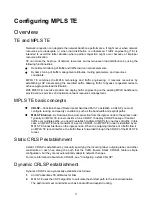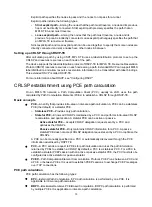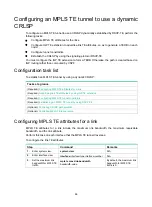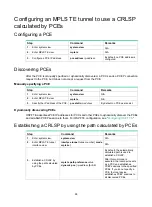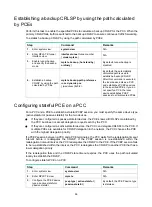
83
14.
Create a tunnel interface on the ingress node of the MPLS TE tunnel. On the tunnel interface,
specify the tunnel destination address (the egress node IP address), and configure MPLS TE
tunnel constraints (such as the tunnel bandwidth constraints and affinity).
15.
Configure link TE attributes (such as the maximum link bandwidth and link attribute) on each
interface that the MPLS TE tunnel traverses.
16.
Configure an IGP on each node that the MPLS TE tunnel traverses, and configure the IGP to
support MPLS TE. Then, the nodes can advertise the link TE attributes through the IGP.
17.
Configure the ingress node of the MPLS TE tunnel to use the path calculated by the PCE.
Manually specify the PCE or configure OSPF TE to dynamically discover the PCE on the
ingress node (PCC).
18.
On the ingress node of the MPLS TE tunnel, configure RSVP-TE to establish a CRLSP based
on the path calculated by the PCE.
19.
On the ingress node of the MPLS TE tunnel, configure static routing, PBR, or automatic route
advertisement to direct traffic to the MPLS TE tunnel.
After the CRLSP is established, configure the stateful PCE feature on both the PCC and the PCE.
Then, the PCE knows all CRLSPs maintained by the PCC and recalculates and optimizes the
CRLSPs delegated by the PCC.
You can also configure other MPLS TE features such as the DS-TE, automatic bandwidth
adjustment, and FRR as needed.
To configure MPLS TE, perform the following tasks:
Tasks at a glance
(Required.)
(Required.)
Configuring a tunnel interface
(Optional.)
(Required.) Perform one of the following tasks to configure an MPLS TE tunnel:
•
Configuring an MPLS TE tunnel to use a static CRLSP
•
Configuring an MPLS TE tunnel to use a dynamic CRLSP
•
Configuring an MPLS TE tunnel to use a CRLSP calculated by PCEs
(Required.)
Configuring traffic forwarding
:
•
Configuring static routing to direct traffic to an MPLS TE tunnel
•
Configuring PBR to direct traffic to an MPLS TE tunnel
•
Configuring automatic route advertisement to direct traffic to an MPLS TE tunnel
(Optional.)
Configuring a bidirectional MPLS TE tunnel
(Optional.)
Only MPLS TE tunnels established by RSVP-TE support this configuration.
(Optional.)
Only MPLS TE tunnels established by RSVP-TE support this configuration.
(Optional.)
(Optional.)
Enabling SNMP notifications for MPLS TE
Enabling MPLS TE
Enable MPLS TE on each node and interface that the MPLS TE tunnel traverses.
Before you enable MPLS TE, perform the following tasks:
•
Configure static routing or IGP to ensure that all LSRs can reach each other.



